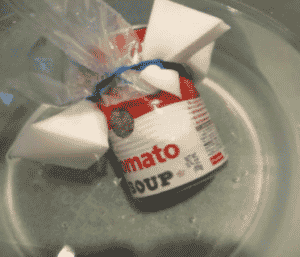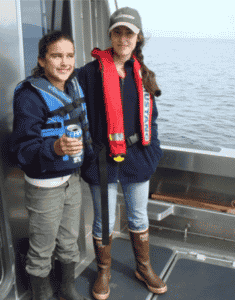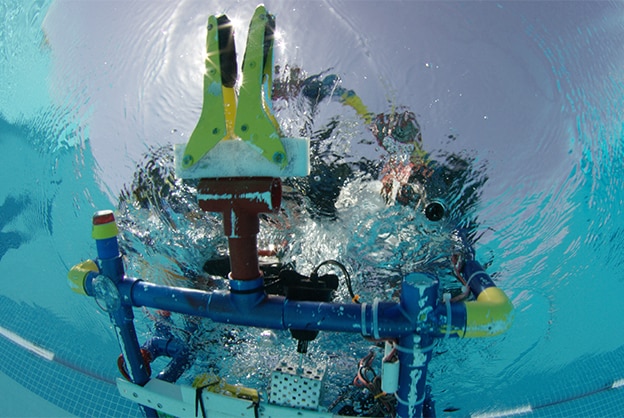Overview
STEM careers
Time
Materials
Supplies & Equipment:
|
Consumables:
|
Relevant Terminology
Buoyancy: An object’s ability to float in water or other fluid.
Density: How much something weighs as compared to how big it is—or, an object’s mass per unit volume. Something big and light, like a balloon, has low density. Something small and heavy, like a rock, has high density.
Fluid displacement: Occurs when an object is placed in a fluid, pushing the fluid out of the way and taking its place.
Introduce
GETTING READY

Image credit: Try Engineering.
Fill a basin with enough water that a soup can will sink to the bottom. Arrange materials neatly so that participants can see the options available to them. Make sure your soup cans sink in advance.
INTRODUCTION
A personal flotation device (PFD), or life vest/jacket, is designed to keep a person afloat with their chin above water in the event of an emergency.
- Have you ever used a PFD before? What was it like? (Some are passive—use foam to float; others are inflatable.)
- Do people always wear a flotation device on a boat? Why might they not? (Some people don’t like to wear a PFD because of how they look or fit. Engineers are creating new PFD designs to make them more likely to be used by everyone on the water.)
- What do you think people used before modern PFDs were invented? (Life jackets made of cork were available in the early 19th century. Inflatable life vests were invented in 1928.)
Instructions

The two main types of PFDs. The person on the right is wearing an inflatable vest; the person on the left is wearing a passive foam flotation vest. Credit: Nancy Heise/Wikimedia Commons.
Introduce the design challenge. Participants will design a flotation device for a soup can. (Note that you can choose to limit use of materials to fit your time or space constraints, but otherwise participants may use any of the materials provided.) Tell participants:
- The goal is to keep the can afloat for 1 minute. (It takes 60 seconds for an adult and 20 seconds for a child to drown.)
- Design the PFD to be removable. People don’t go boating with a life jacket glued to their bodies!
Invite teams to design and build the flotation device and test it in the basin of water. Some tips:
- Use balloons, foam pieces, or corks to design a PFD that keeps the can afloat.
- Some participants may decide to build an inflatable device, while others may choose to build a passive flotation device. Straws may be used to inflate balloons or sandwich bags after the flotation device is placed on the can.
Ask questions while teams are testing their designs. What worked and what didn’t work? What would you do differently? Encourage them to modify their prototype or try a completely new design.
Evaluate the success of each design:
- Did the can stay afloat for at least 60 seconds?
- Did the can float horizontally? Vertically? What if the can were a person—how would it float?
ACTIVITY VARIATIONS
- Draw a face on the can and challenge participants to design a PFD that keeps the face above water at all times.
- Design a PFD for a brick or other heavy object.
- Some people don’t like to wear a PFD because they are bulky. Design an effective PFD using the fewest materials possible.
- Design the PFD on paper before building a prototype. Compare and debate the merits of each plan. Choose one device to build.
TROUBLESHOOTING
Some participants may try to build a life raft instead of a life jacket. Validate their thinking, but positively redirect them to try the task at hand.
Guiding questions
GUIDANCE FOR YOUNGER CHILDREN
QUESTIONS TO ASK AFTER THE ACTIVITY
- Why do you think a soup can sinks?
- What are some things that float?
- What do you wear to help you float when you go swimming? Or what have you seen people wear to help them float?
- What are toys that float in the bathtub made of?
- What material(s) did you use to make your soup can float?
- What materials might help your soup can float for more than a minute?
GUIDANCE FOR OLDER YOUTH AND ADULTS
QUESTIONS TO ASK AFTER THE ACTIVITY
- What causes an object to float or sink?
- What did you consider the most important goals of your PFD design?
- What material(s) did you use in the design of your soup can PFD?
- Did your soup can float for at least a minute? Why or why not?
- Did you refine your design during the building process? Why or why not?
- How do giant cruise ships stay afloat?
Engineering & science connections
GUIDANCE FOR YOUNGER CHILDREN
Engineering Connections
Engineers not only design new products, called inventions, but they also redesign existing products, called innovations. For example, over 200 years ago, people invented personal floatation devices (PFDs), or what many people call life jackets. PFDs helped keep people from drowning. But now engineers have made innovations that make today’s PFDs much better than the first PFDs. In fact, engineers are continually improving the designs of PFDs. PFDs that we use today are designed not only for the people using them but also specially for the activities that the person is doing. For example, what would happen if you were waterskiing and you fell over and got knocked out? Fortunately, an engineer has designed a PFD to save your life! Not only will certain types of PFDs keep you afloat, but they are designed to keep your face out of the water in case you are unconscious and can’t do it yourself. So, sometimes an innovation is even cooler than the invention!
Science Connections
What makes something sink or float? It depends on the chemical makeup of the substance. Everything in the universe is made of matter. Matter is anything that has mass and takes up space—which means almost everything! Matter could be rock, plastic, air, wood, Styrofoam, metal, or any other substance you can think of. Matter is made up of tiny particles called molecules, which in turn are made up of even smaller particles called atoms.
One characteristic that makes atoms of different substances different from each other is something called density, which is how much something weighs compared to how much space it takes up. Think about a handful of hair and a handful of rocks. They both take up the same amount of space. But one of them, the handful of rocks, is much heavier. That means that the density of the rocks is higher than the density of the hair. Oil and water also have different densities and, as a result, oil (with lower density) will float on top of water. This is also why life jackets and other PFDs float on water: they have a lower density than the water!
GUIDANCE FOR OLDER YOUTH AND ADULTS
Engineering Connections
How is it possible that a cruise ship weighing over 71,000 tons floats in water? The answer to this question lies in the principles of density and buoyancy. In order for a cruise ship to stay afloat, the ship must displace its weight in water before it is submerged. As the boat displaces water and pushes down on the water, the water below the cruise ship pushes up and keeps the boat afloat, or buoyant. Displacing enough water to keep a cruise ship afloat is easier to do if the ship is constructed so that it is less dense than the water below it. The same principles are used when designing PFDs.
In order to help ships be as buoyant as possible, nautical engineers choose lightweight materials for construction and are careful to evenly disperse the ship’s weight across the entire hull. By spreading out the weight over a large volume, the engineers have reduced the density of the ship so that it is now less than the water in which it floats. PFDs do the exact same thing. The design of the life jacket results in the wearer’s density near her head being much less than water. This ensures that if the wearer falls in the water, her head will stay above the surface even if she is unconscious!
Science Connections
Whether an object floats or sinks depends on its density (mass per unit volume), and the density of an object depends on the type of matter from which it is made. When two liquids with different densities are mixed (like water and oil), the liquids will separate according to their densities so that the liquid with the lower density is on top and the denser liquid is on the bottom. Water has a density of 1.0 g/cm3, so any object with a density greater than 1.0 g/cm3 will sink in water.
An object’s ability to float is known as its buoyancy. Objects that float in water are considered positively buoyant while objects that sink in water are considered to be negatively buoyant. The amount of water that an object displaces is equal to the mass of the object, so the object will continue to sink until it has displaced an amount of water equal to its own mass. If that mass of water is displaced while the object is still above the surface, then it will float!
Activity courtesy of IEEE TryEngineering.org. All rights reserved. http://tryengineering.org/sites/default/files/lessons/lifevest.pdf
Supplemental content adapted for Dream Big Activities by the Carnegie Science Center.


0 Comments